-
Countries
-
Data and Analysis
-
Special Focus
-
Crisis Responses
Registration
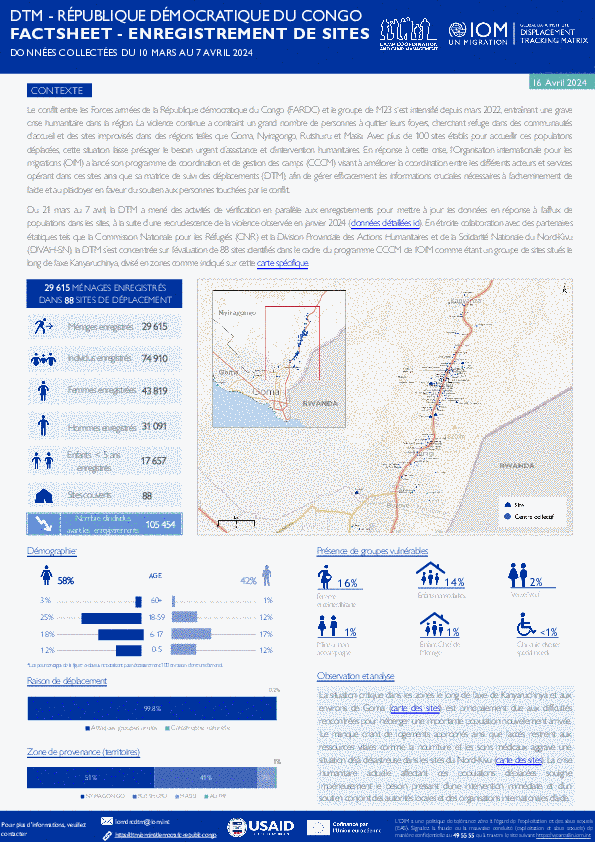
Contact
DTM DRC, iomdrcdtm@iom.int
Language
French
Location
Democratic Republic of the Congo
Period Covered
Mar 10 2024
Apr 07 2024
Activity
- Registration
- Rapid Emergency Registration
- Verification for Registration
Le conflit entre les Forces armées de la République démocratique du Congo (FARDC) et le groupe de M23 s’est intensifié depuis mars 2022, entraînant une grave crise humanitaire dans la région. La violence continue a contraint un grand nombre de personnes à quitter leurs foyers, cherchant refuge dans des communautés d’accueil et des sites improvisés dans des régions telles que Goma, Nyiragongo, Rutshuru et Masisi. Avec plus de 100 sites établis pour accueillir ces populations déplacées, cette situation laisse présager le besoin urgent d’assistance et d’intervention humanitaires. En réponse à cette crise, l’Organisation internationale pour les migrations (OIM) a lancé son programme de coordination et de gestion des camps (CCCM) visant à améliorer la coordination entre les différents acteurs et services opérant dans ces sites ainsi que sa matrice de suivi des déplacements (DTM), afin de gérer efficacement les informations cruciales nécessaires à l’acheminement de l’aide et au plaidoyer en faveur du soutien aux personnes touchées par le conflit.
Du 21 mars au 7 avril, la DTM a mené des activités de vérification en parallèle aux enregistrements pour mettre à jour les données en réponse à l’afflux de populations dans les sites, à la suite d'une recrudescence de la violence observée en janvier 2024. En étroite collaboration avec des partenaires étatiques tels que la Commission Nationale pour les Réfugiés (CNR) et la Division Provinciale des Actions Humanitaires et de la Solidarité Nationale du Nord-Kivu (DIVAH-SN), la DTM s’est concentrée sur l’évaluation de 88 sites identifiés dans le cadre du programme CCCM de l’OIM comme étant un groupe de sites situés le long de l’axe Kanyaruchinya.
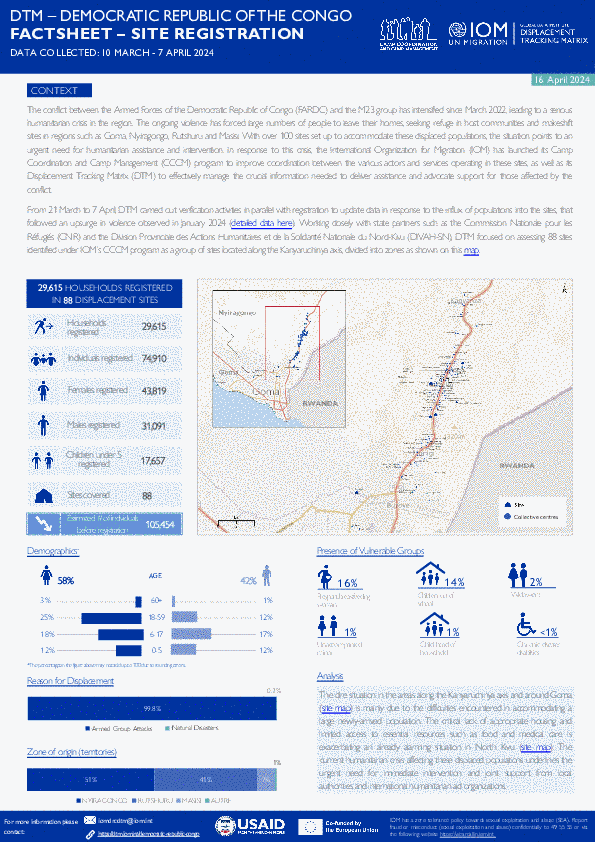
Contact
DTM DRC, iomdrcdtm@iom.int
Language
English
Location
Democratic Republic of the Congo
Period Covered
Mar 10 2024
Apr 07 2024
Activity
- Registration
- Rapid Emergency Registration
- Verification for Registration
The conflict between the Armed Forces of the Democratic Republic of Congo (FARDC) and the M23 group has intensified since March 2022, leading to a serious humanitarian crisis in the region. The ongoing violence has forced large numbers of people to leave their homes, seeking refuge in host communities and makeshift sites in regions such as Goma, Nyiragongo, Rutshuru and Masisi. With over 100 sites set up to accommodate these displaced populations, the situation points to an urgent need for humanitarian assistance and intervention. In response to this crisis, the International Organization for Migration (IOM) has launched its Camp Coordination and Camp Management (CCCM) program to improve coordination between the various actors and services operating in these sites, as well as its Displacement Tracking Matrix (DTM) to effectively manage the crucial information needed to deliver assistance and advocate support for those affected by the conflict.
From 21 March to 7 April, DTM carried out verification activities in parallel with registration to update data in response to the influx of populations into the sites, that followed an upsurge in violence observed in January 2024. Working closely with state partners such as the Commission Nationale pour les Réfugiés (CNR) and the Division Provinciale des Actions Humanitaires et de la Solidarité Nationale du Nord-Kivu (DIVAH-SN), DTM focused on assessing 88 sites identified under IOM's CCCM program as a group of sites located along the Kanyaruchinya axis.
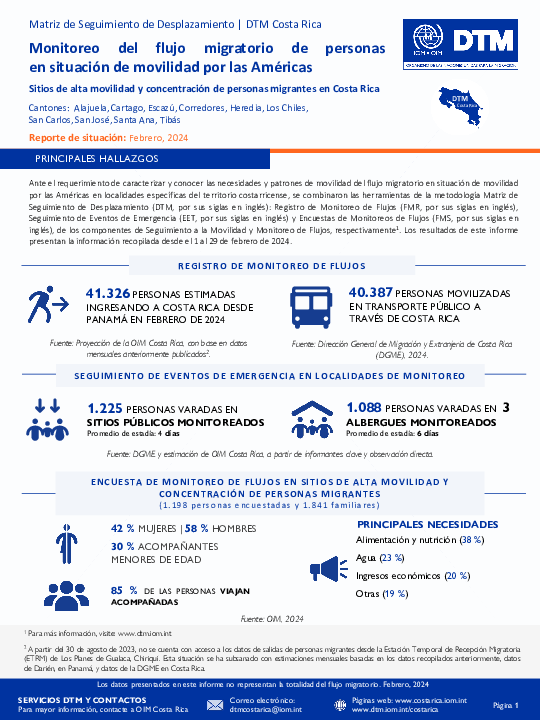
Contact
Angélica Madrigal amadrigal@iom.int
Language
English
Location
Costa Rica
Period Covered
Feb 01 2024
Feb 29 2024
Activity
- Survey
- Registration
- Flow Monitoring
Cantones: Alajuela, Cartago, Escazú, Corredores, Heredia, Los Chiles, San Carlos, San José, Santa Ana, Tibás
Costa Rica, al igual que los demás países de la región centroamericana, se ha caracterizado por ser un corredor migratorio para personas que transitan de manera terrestre desde el sur hasta el norte de América y que tienen como destino los países del norte del continente. Este flujo en situación de movilidad por las Américas se encuentra compuesto principalmente por personas de la República Bolivariana de Venezuela, Cuba, Haití, Ecuador, así como personas provenientes de otros países de Suramérica, África y Asia.
Según estimaciones de la OIM Costa Rica, durante febrero ingresaron al país 41.326 personas, un promedio aproximado de 1.425 personas por día y estimando un aumento de un 10% con respecto a enero de 2024. Además, se identificaron 1.088 personas varadas en los albergues monitoreados y 1.225 personas varadas en los sitios públicos visitados.

Contact
Angélica Madrigal amadrigal@iom.int
Language
English
Location
Costa Rica
Period Covered
Jan 01 2024
Jan 30 2024
Activity
- Survey
- Registration
- Flow Monitoring
Cantones: Alajuela, Cartago, Corredores, Desamparados, Heredia, Liberia, Los Chiles, San Carlos, San José, Santa Ana y Tibás
Costa Rica, al igual que los demás países de la región centroamericana, se ha caracterizado por ser un corredor migratorio para personas que transitan de manera terrestre desde el sur hasta el norte de América y que tienen como destino los países del norte del continente. Este flujo en situación de movilidad por las Américas se encuentra compuesto principalmente por personas de la República Bolivariana de Venezuela, Cuba, Haití, Ecuador, así como personas provenientes de otros países de Suramérica, África y Asia.
Según estimaciones de la OIM Costa Rica, durante enero ingresaron al país 37.436 personas, un promedio aproximado de 1.208 personas por día y estimando un aumento de un 30% con respecto a diciembre de 2023. Además, se identificaron 1.407 personas varadas en los albergues monitoreados y 732 personas varadas en los sitios públicos visitados.

Contact
DTM Nigeria, iomnigeriadtm@iom.int
Language
English
Location
Nigeria
Snapshot Date
Jan 01 2024
Activity
- Registration
- Biometric Registration
Six LGAs have been mapped as locations with IDPs in Benue State based on DTM Round 11 (March 2023). So far, the biometrically registered IDPs have covered the location of Makurdi LGA (five camps and two host community sites), Guma LGA (two camps and two host community sites), Logo LGA (two camps and host community sites), Kwande (one camp and host community site) Agatu LGA (two host community sites) and in Gwer West (two camps and host community sites). The registration has shown that Guma LGA has the highest number of IDPs, with 33,586 individuals (9,513 households), followed by Agatu with 21,861 individuals (5,641 households), then Kwande with 15,909 individuals (3,225 households). Makurdi had 14,041 individuals (4,150 households), while Logo had 13,633 individuals (3,311 households). The registration which is currently on a break in Gwer West LGA, had 12,721 registered individuals (3,435 households). During the registration, 13,766 individuals were identified with vulnerabilities and specific needs (including but not limited to serious medical illness) and were referred to UNHCR/FJDP for further support. All registered IDPs have received a biometric card with a unique number for easy identification. The registration is an ongoing process as this serves as the third report in the series.

Contact
DTM Nigeria, iomnigeriadtm@iom.int
Language
English
Location
Nigeria
Snapshot Date
Nov 30 2023
Activity
- Registration
- Biometric Registration
Six LGAs have been mapped as locations with IDPs in Benue State based on DTM Round 11 (March 2023). So far, the biometrically registered IDPs have covered the location of Makurdi LGA (5 camps and 2 host community sites), Guma LGA (2 camps and two host community sites), Logo LGA (2 camps and 2 host community sites), Kwande (1 camp and 1 host community site) and currently ongoing in Agatu LGA (2 host community sites).
The registration has shown that Guma LGA has the highest number of IDPs, with 23,283 individuals (6,750 households), followed by Kwande with 15,934 individuals (3,232 households), then Makurdi with 14,041 individuals (4,150 households). Logo had 13,632 individuals (3,314 households). The registration is ongoing in Agatu LGA, with 21,895 registered individuals (5,649 households).
During the registration, 10,191 individuals were identified with vulnerabilities and specific needs (including but not limited to serious medical illness) and have been referred to UNHCR/FJDP for further support. All registered IDPs have received biometric cards with unique numbers for easy identification. The registration is an ongoing process.
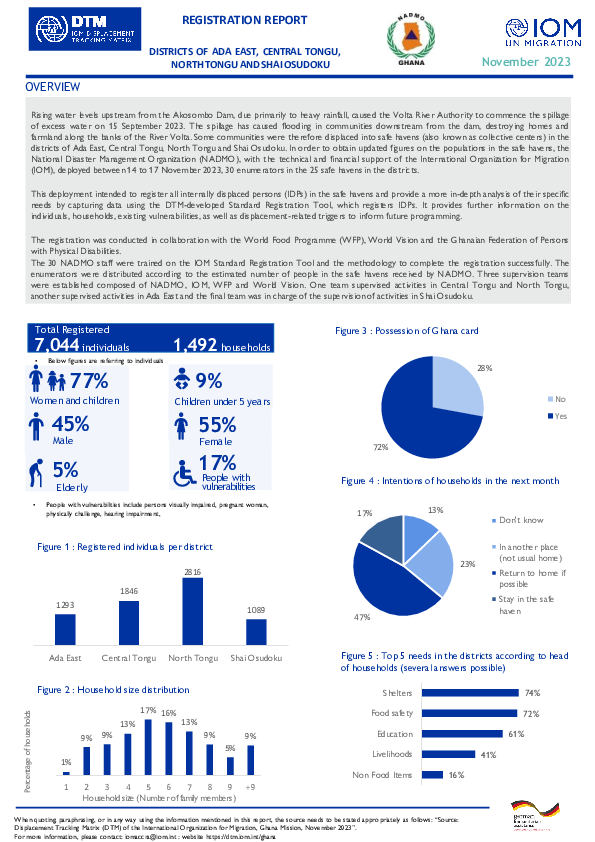
Contact
iomaccra@iom.int
Language
English
Location
Ghana
Period Covered
Nov 14 2023
Nov 17 2023
Activity
- Registration
Rising water levels upstream from the Akosombo Dam, due primarily to heavy rainfall, caused the Volta River Authority to commence the spillage of excess water on 15 September 2023. The spillage has caused flooding in communities downstream from the dam, destroying homes and farmland along the banks of the River Volta. Some communities were therefore displaced into safe havens (also known as collective centers) in the districts of Ada East, Central Tongu, North Tongu and Shai Osudoku. In order to obtain updated figures on the populations in the safe havens, the National Disaster Management Organization (NADMO), with the technical and financial support of the International Organization for Migration (IOM), deployed between 14 to 17 November 2023, 30 enumerators in the 25 safe havens in the districts.
This deployment intended to register all internally displaced persons (IDPs) in the safe havens and provide a more in-depth analysis of their specific needs by capturing data using the DTM-developed Standard Registration Tool, which registers IDPs. It provides further information on the individuals, households, existing vulnerabilities, as well as displacement-related triggers to inform future programming.
The registration was conducted in collaboration with the World Food Programme (WFP), World Vision and the Ghanaian Federation of Persons with Physical Disabilities.
The 30 NADMO staff were trained on the IOM Standard Registration Tool and the methodology to complete the registration successfully. The enumerators were distributed according to the estimated number of people in the safe havens received by NADMO. Three supervision teams were established composed of NADMO, IOM, WFP and World Vision. One team supervised activities in Central Tongu and North Tongu, another supervised activities in Ada East and the final team was in charge of the supervision of activities in Shai Osudoku.
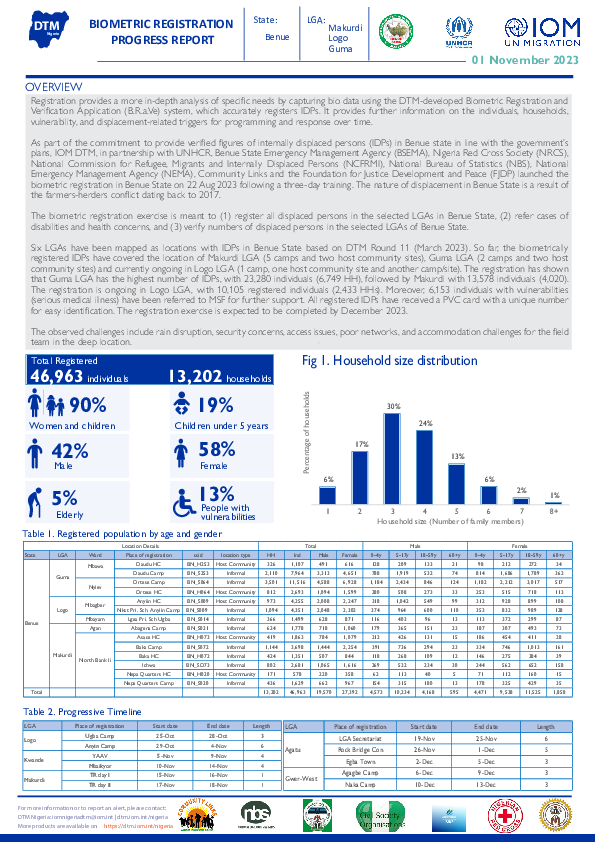
Contact
DTM Nigeria, iomnigeriadtm@iom.int
Language
English
Location
Nigeria
Snapshot Date
Nov 01 2023
Activity
- Registration
- Biometric Registration
Registration provides a more in-depth analysis of specific needs by capturing bio data using the DTM-developed Biometric Registration and Verification Application (B.R.a.Ve) system, which accurately registers IDPs. It provides further information on the individuals, households, vulnerability, and displacement-related triggers for programming and response over time.
As part of the commitment to provide verified figures of internally displaced persons (IDPs) in Benue State in line with the government’s plans, IOM DTM, in partnership with UNHCR, Benue State Emergency Management Agency (BSEMA), Nigeria Red Cross Society (NRCS), National Commission for Refugee, Migrants and Internally Displaced Persons (NCFRMI), National Bureau of Statistics (NBS), National Emergency Management Agency (NEMA), Community Links and the Foundation for Justice Development and Peace (FJDP) launched the biometric registration in Benue State on 22 August 2023.
Six LGAs have been mapped as locations with IDPs in Benue State based on DTM Round 11 (March 2023). So far, the biometrically registered IDPs have covered the location of Makurdi LGA (5 camps and two host community sites), Guma LGA (2 camps and two host community sites) and currently ongoing in Logo LGA (1 camp, one host community site and another camp/site). The registration has shown that Guma LGA has the highest number of IDPs, with 23,280 individuals (6,749 HHs), followed by Makurdi with 13,578 individuals (4,020 HHs). The registration is ongoing in Logo LGA, with 10,105 registered individuals (2,433 HHs).
Moreover, 6,153 individuals with vulnerabilities (serious medical illness) have been referred to MSF for further support. All registered IDPs have received a PVC card with a unique number for easy identification. The registration exercise is expected to be completed by December 2023.
The observed challenges include rain disruption, security concerns, access issues, poor networks, and accommodation challenges for the field team in the deep location.
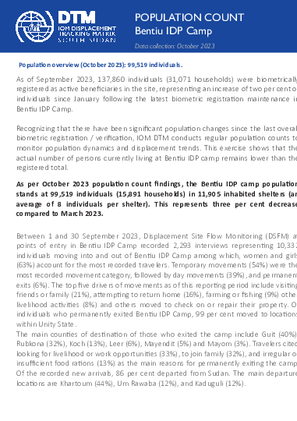
Contact
DTM South Sudan, SouthSudanDTM@iom.int
Language
English
Location
South Sudan
Period Covered
Oct 05 2023
Oct 08 2023
Activity
- Registration
- Flow Monitoring
- Mobility Tracking
- Site Assessment
As per October 2023 population count findings, the Bentiu IDP camp population stands at 99,519 individuals (15,891 households) in 11,905 inhabited shelters (an average of 8 individuals per shelter). This represents three per cent decrease compared to March 2023.

Contact
DTM Nigeria, iomnigeriadtm@iom.int
Language
English
Location
Nigeria
Period Covered
Jul 01 2023
Aug 30 2023
Activity
- Registration
- Biometric Registration
In an effort to ensure lasting solutions for internally displaced persons (IDPs), the International Organization for Migration (IOM) has undertaken a mission to identify IDPs who are on the path to sustainable solutions and gain a better understanding of the composition of communities/camps hosting IDPs, with the intention of informing humanitarian communities and government agencies.
Between 01 June and 30 August 2023, the displacement tracking matrix (DTM) conducted a biometric verification and registration exercise in several locations, including Malkohi new city, Daware camp, Labondo, and Salama housing camp. The primary objectives of this exercise were to identify the residents of these areas and to create profiles for vulnerable individuals within these communities/camp.
As of 30 August 2023, the DTM using the biometric registration and verification app successfully recorded the details of 2,004 IDPs from 375 house-holds in Daware camp, 1,788 IDPs from 323 households in Labondo, 491 IDPs from 99 households in Salama housing camp, and 1,107 IDPs from Malkohi new city. Data gathered from this exercise revealed that 16 per cent of households consist of 1-2 members, 27 per cent have 3-4 members, 25 per cent have 5-6 members, 17 per cent have 7-8 members, and 14 per cent have 9 or more members. On average, households in these locations consist of six members.
Throughout the exercise, a total of 534 vulnerable individuals were identified and their profiles were created. This includes 191 individuals in Daware camp, 164 individuals in Labondo, 127 in Malkohi new city, and 52 individuals in Salama housing camp. Among the vulnerable population, 55 per cent are breastfeeding mothers, followed by pregnant women accounting for 14 per cent of the total vulnerable population.
Pagination
- Page 1
- Next page